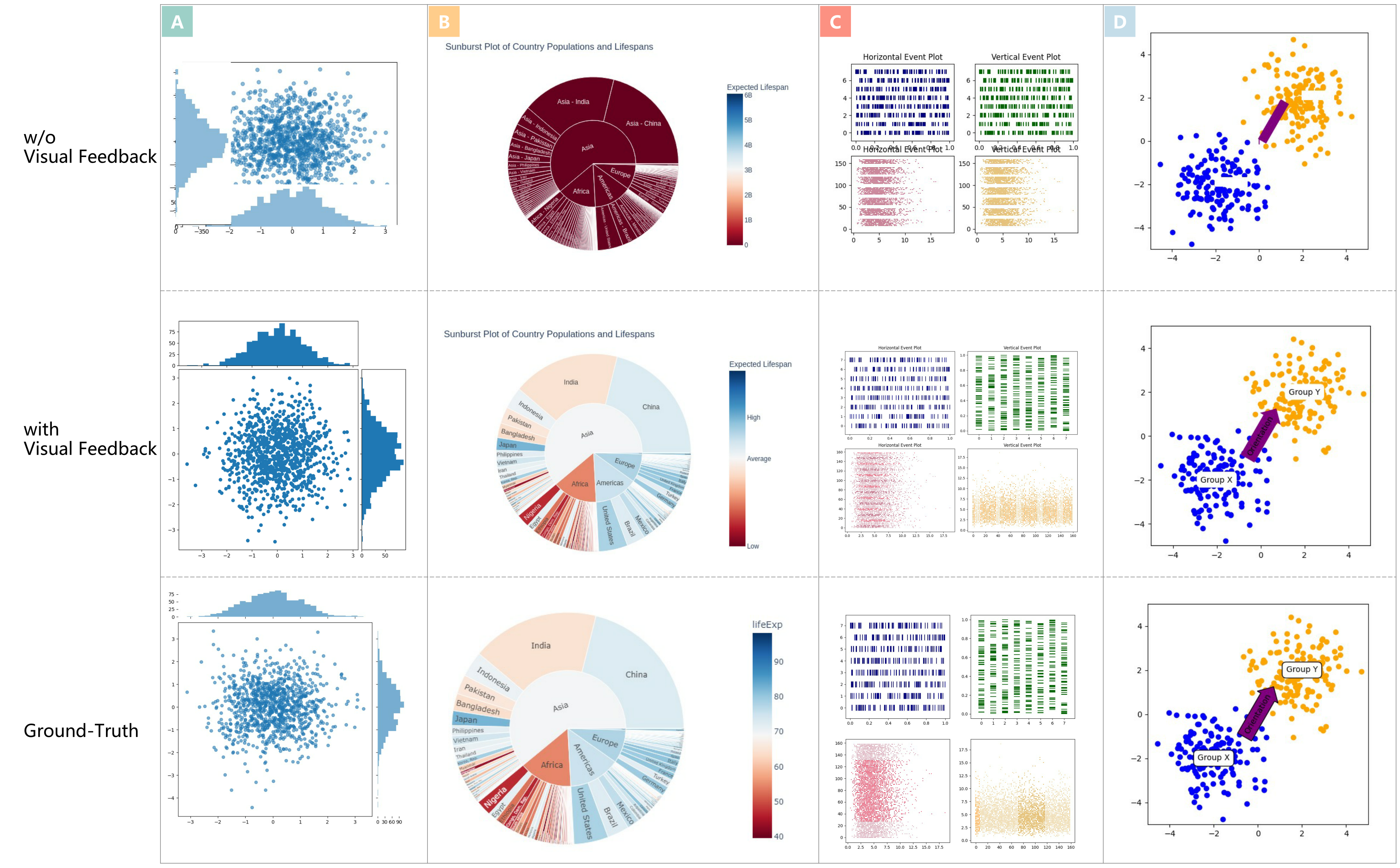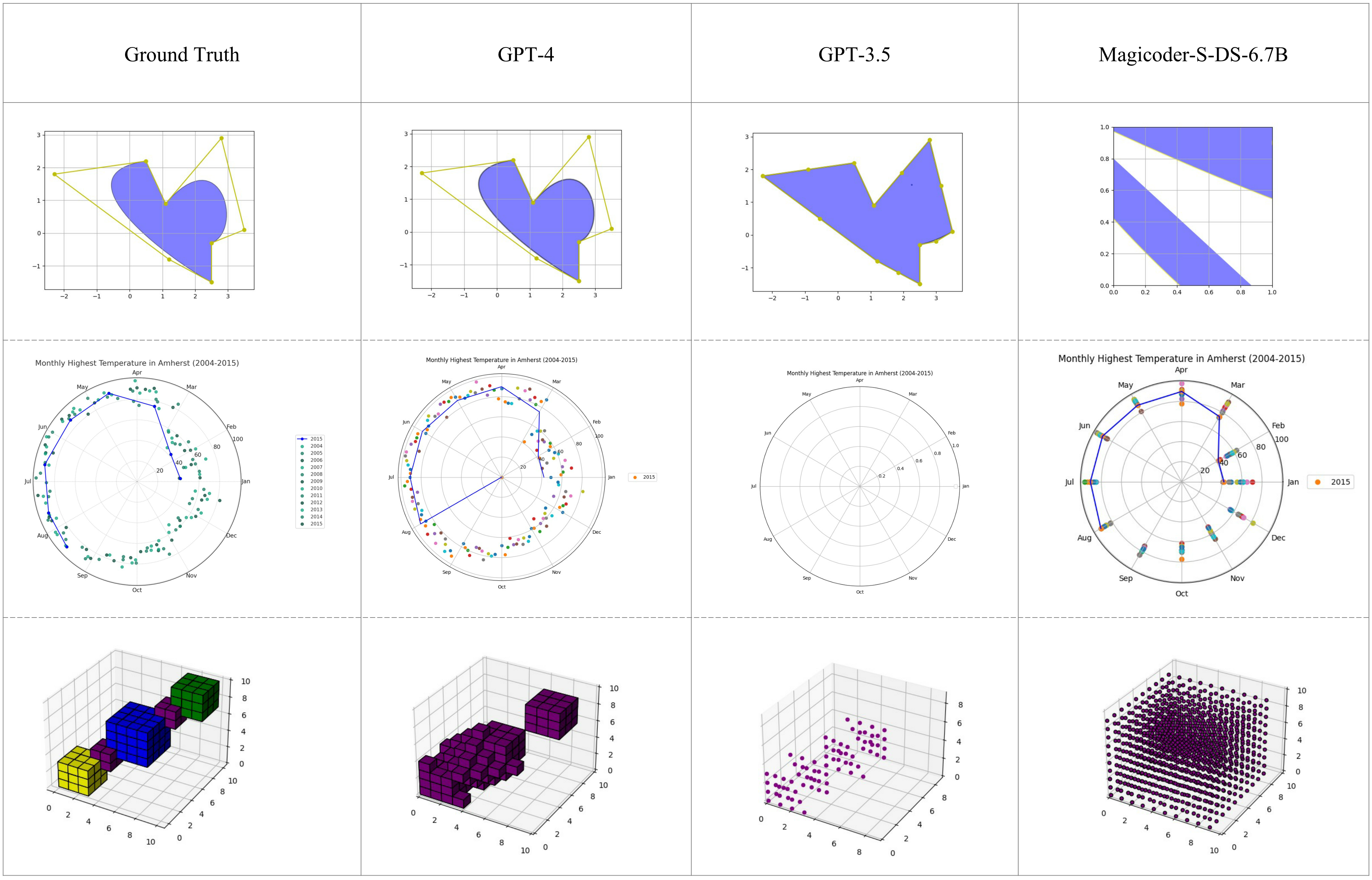
MatPlotAgent: Enhancing Scientific Data Visualization with LLMs
• 📖Introduction • 🎉News • ✨MatPlotAgent • 🎖MatPlotBench
• ⚡️Getting Started • 📊Experiment Results • 🔎Citation • 📃Paper
Scientific data visualization is crucial for conveying complex information in research, aiding in the identification of implicit patterns. Despite the potential, the use of Large Language Models (LLMs) for this purpose remains underexplored. MatPlotAgent introduces an innovative, model-agnostic LLM agent framework designed to automate scientific data visualization tasks, harnessing the power of both code LLMs and multi-modal LLMs.
Integrating LLMs into scientific data visualization represents a new frontier in technology that supports research. Existing tools, such as Matplotlib and Origin, are challenging for many people and learning these tools is time-consuming. MatPlotAgent is conceived to bridge this gap, leveraging LLM capabilities to enhance human efficiency significantly. MatPlotBench is curated to further traction the field of AI-automated scientific data visualization by providing a comprehensive benchmark and trustworthy automatic evaluation method.
- March 7, 2024: Releasing the MatPlotAgent, an innovative and model-agnostic framework designed to revolutionize scientific data visualization by automating tasks with advanced LLMs. 🎊
- March 7, 2024: Releasing MatPlotBench, a comprehensive and meticulously curated benchmark that sets a new standard for evaluating AI-driven visualization tools. 🌟
- Query Expansion: Thoroughly interprets user requirements and transform them into LLM-friendly instructions
- Code Generation with Iterative Debugging: Uses code to preprocess data and generate figures, with self-debugging capabilities.
- Visual Feedback Mechanism: Employs visual perceptual abilities for error identification and correction.
- Generalizability: Demonstrated effectiveness with various LLMs, including commercial and open-source models.
A high-quality benchmark of 100 human-verified test cases alongside a scoring approach utilizing GPT-4V for automatic evaluation, demonstrating strong correlation with human-annotated scores.
This project opensources the following components to foster further research and development in the field of scientific data visualization:
- Benchmark Data (MatPlotBench): A meticulously crafted benchmark to quantitatively evaluate data visualization approaches.
- Evaluation Pipeline: Utilizes GPT-4V for automatic evaluation, offering a reliable metric that correlates strongly with human judgment.
- MatPlotAgent Framework: The entire codebase for the MatPlotAgent framework is available, encouraging adaptation and improvement by the community.
Benchmark Data (MatPlotBench) can be found in the ./benchmark_data folder.
The code requires some dependencies as specified in requirements.txt. Please follow the relevant libraries to install or run:
pip install -r requirements.txt
If you're using the open-source model, please download the model to your local machine first and adjust the location of the corresponding model in models/model_config.py.
If you're using GPT-3.5 or GPT-4, please update your API_KEY in agents/config/openai.py.
If you're utilizing GPT-3.5 or GPT-4, you can skip this section.
We use vLLM to deploy the open-source model as a server, implementing the OpenAI API protocol. This enables vLLM to seamlessly replace applications using the OpenAI API.
Ensure you have vLLM installed and configured on your local machine.
We provide scripts to deploy the API server. For instance, to deploy CodeLlama-34b-Instruct, you can execute:
bash models/scripts/CodeLlama-34b-Instruct-hf.sh
If you need to modify the script's content, please refer to the vLLM documentation.
To execute the MatPlotAgent framework, use the following script:
python workflow.py \
--model_type=MODEL \
--workspace=path/to/resultReplace MODEL with the desired model. All available model_type options can be found in models/model_config.py.
Replace path/to/result with the desired path to save the results.
For direct decoding, use:
python one_time_generate.py \
--model_type=MODEL \
--workspace=path/to/resultFor zero-shot COT, use:
python one_time_generate_COT.py \
--model_type=MODEL \
--workspace=path/to/resultAfter running the MatPlotAgent Framework, you can utilize the Evaluation Pipeline to obtain automatic evaluation scores.
First, replace directory_path with path/to/result in evaluation/api_eval.py and evaluation/average_score_calc.py.
Then, run:
bash evaluation/eval.shAfter running the above command, execute:
cd evaluation
python average_score_calc.pyYou will receive the score.
Our experiments showcase MatPlotAgent's ability to improve LLM performance across a variety of aspects, with notable enhancements in plot quality and correctness, supported by both quantitative scores and qualitative assessments.
Performance of different LLMs on MatPlotBench. For each model, improvements over the direct decoding are highlighted in bold.
| Model | Direct Decod. |
Zero-Shot CoT |
MatPlotAgent w/ GPT-4V |
|---|---|---|---|
| GPT-4 | 48.86 | 45.42 (-3.44) | 61.16 (+12.30) |
| GPT-3.5 | 38.03 | 37.14 (-0.89) | 47.51 (+9.48) |
| Magicoder-S-DS-6.7B (Wei et al.,) | 38.49 | 37.95 (-0.54) | 51.70 (+13.21) |
| Deepseek-coder-6.7B-instruct (Guo et al.,) | 31.53 | 29.16 (-2.37) | 39.45 (+7.92) |
| CodeLlama-34B-Instruct (Rozière et al.,) | 16.54 | 12.40 (-4.14) | 14.18 (-2.36) |
| Deepseek-coder-33B-instruct (Guo et al.,) | 30.88 | 36.10 (+5.22) | 32.18 (+1.30) |
| WizardCoder-Python-33B-V1.1 (Luo et al.,) | 36.94 | 35.81 (-1.13) | 45.96 (+9.02) |
Additionally, we present the results of using Gemini Pro Vision as the visual agent on GPT-4 and GPT-3.5, showcasing a considerable improvement of 7.87 and 5.45, respectively, over the direct decoding baseline. This evidence further demonstrates our method's model-agnostic characteristics by using various multimodal LLMs to achieve improved performance.
| Model | Direct Decod. | MatPlotAgent w/ Gemini Pro Vision |
|---|---|---|
| GPT-4 | 48.86 | 56.73 (+7.87) |
| GPT-3.5 | 38.03 | 43.48 (+5.45) |
We assessed MatPlotAgent's performance on the visualization subset of the Code Interpreter Benchmark, which was released alongside Qwen-agent, witnessing notable improvements over GPT-4. These results underscore the efficacy of our approach in enhancing visualization capabilities.
| Model | Accuracy of Code Execution Results (%) | ||
|---|---|---|---|
| Visualization-Hard | Visualization-Easy | Average | |
| GPT-4 | 66.7 | 60.8 | 63.8 |
| + MatPlotAgent | 72.6 | 68.4 | 70.5 |
| w/o Visual Feedback | 66.7 | 65.8 | 66.3 |
Examples to illustrate the effect of visual feedback. To investigate the effect of the visual feedback mechanism on different models, we display the outputs of two representative LLMs. Case A, B, and C are generated by GPT-4. Case D is generated by Magicoder-S-DS-6.7B.
Case study of different models
Feel free to cite the paper if you think MatPlotAgent is useful.
@misc{yang2024matplotagent,
title={MatPlotAgent: Method and Evaluation for LLM-Based Agentic Scientific Data Visualization},
author={Zhiyu Yang and Zihan Zhou and Shuo Wang and Xin Cong and Xu Han and Yukun Yan and Zhenghao Liu and Zhixing Tan and Pengyuan Liu and Dong Yu and Zhiyuan Liu and Xiaodong Shi and Maosong Sun},
year={2024},
eprint={2402.11453},
archivePrefix={arXiv},
primaryClass={cs.CL}
}


